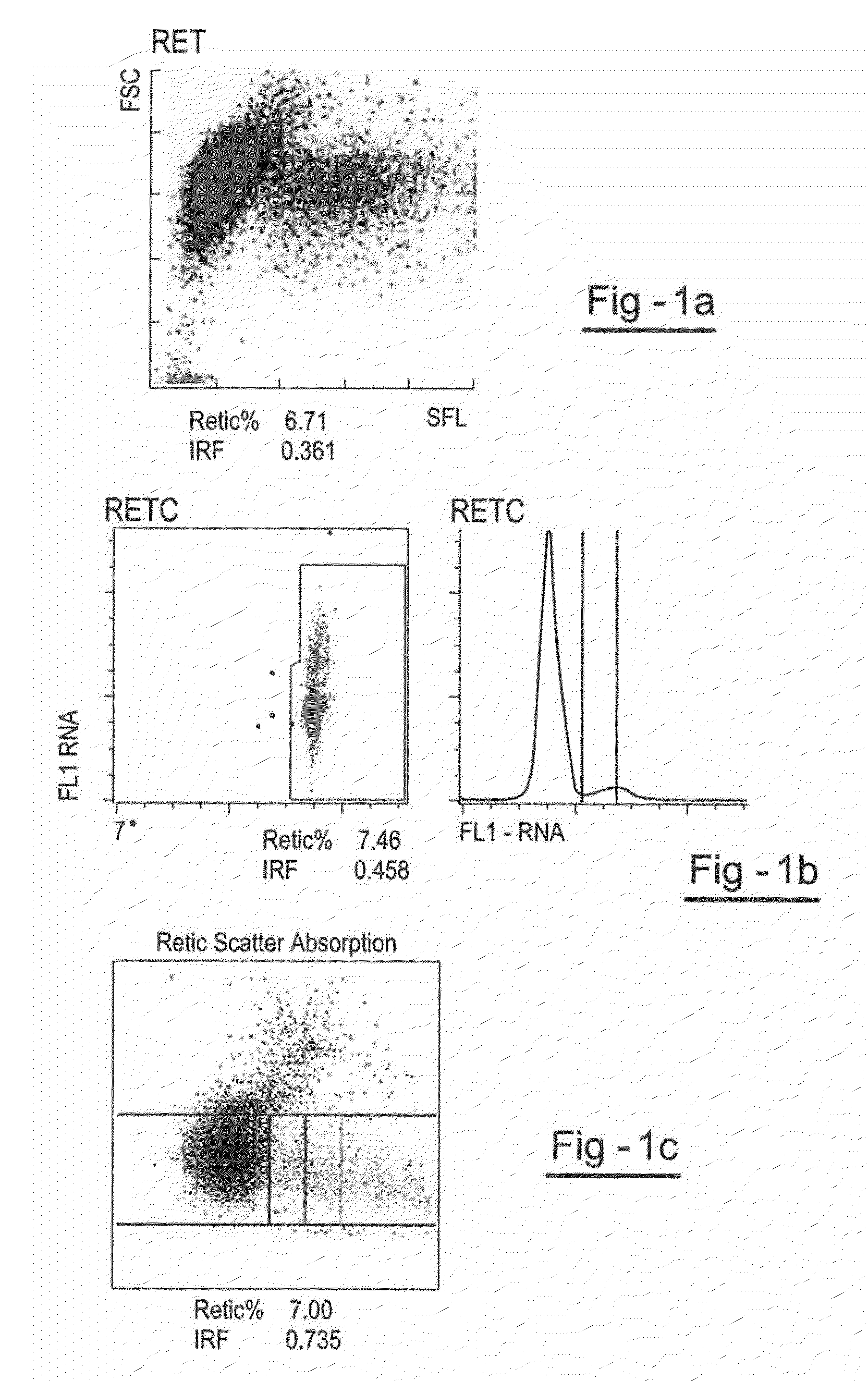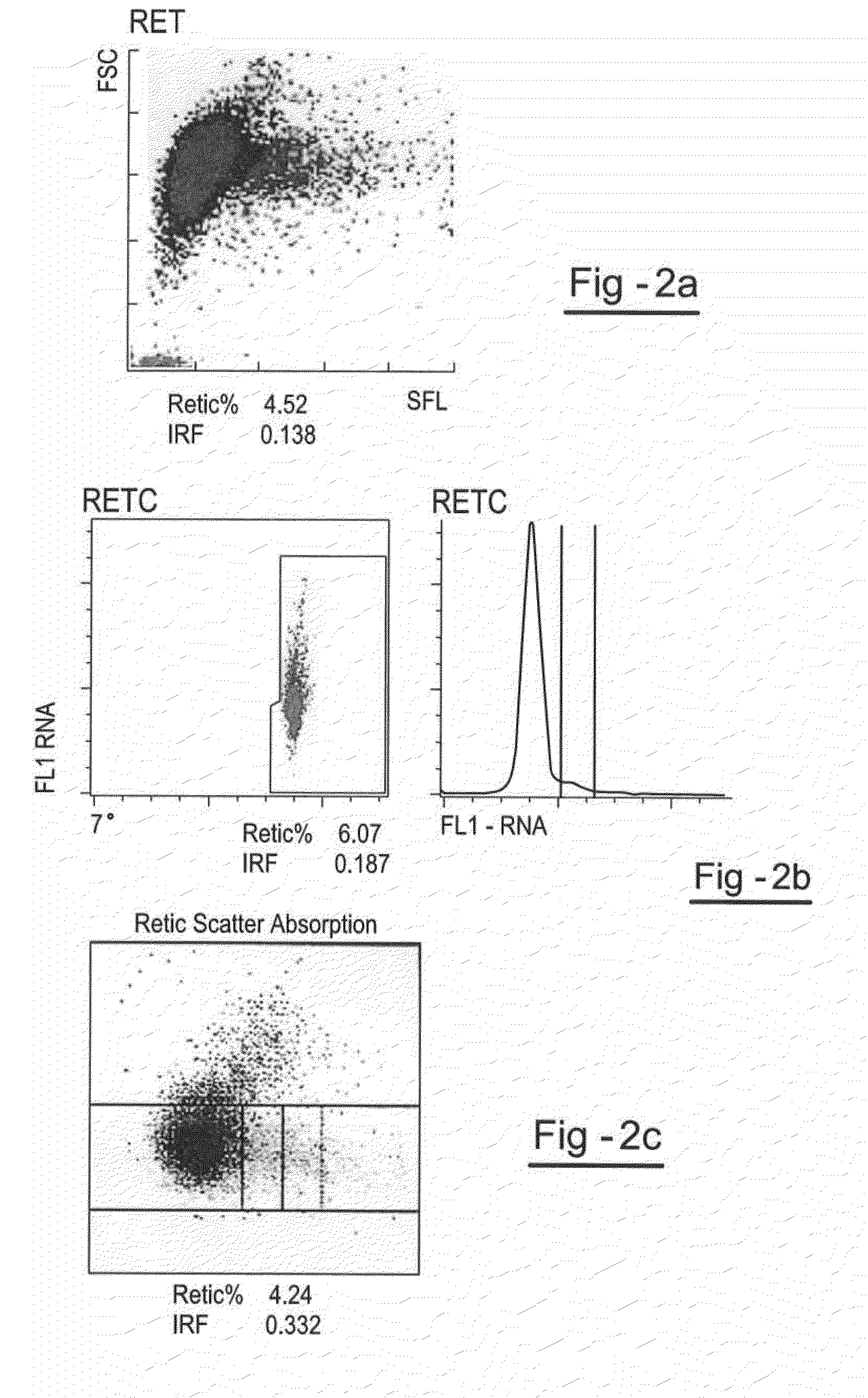Immature Reticulocyte Fraction Reference Control and Related Methods
a technology of reticulocyte fraction and reference control, which is applied in the field of hematology controls, can solve the problems of inability to establish a reference method for determining abnormal irf values, discrepancies in irf recovery between instrument manufacturers, and medical practitioners' inability to use irf data from automated analyzers
- Summary
- Abstract
- Description
- Claims
- Application Information
AI Technical Summary
Benefits of technology
Problems solved by technology
Method used
Image
Examples
example 1
[0086]This example describes the preparation of a reticulocyte component with a relatively high IRF. Human red blood cells (“RBCs”) are prepared by suspending cells in hypotonic stress solution of sodium chloride for up to 24 hours after which time the RBCs are centrifuged and the supernatant is removed. The RBCs are then suspended in a preservative solution at a count of about 2.0×106 / μl and filtered through a leukocyte removal filter.
[0087]The erythrocytes are diluted after filtration. In this step, filtered RBCs are concentrated by centrifugation for 15 minutes at 657×g. The RBC pellet is diluted to a RBC count of 2×106 / μl with a preservative diluent. The RBCs are stored in this diluent for 5-20 days prior to encapsulation.
[0088]A day before encapsulation the RBCs are concentrated by centrifugation for 15 minutes at 657×g, and washed 3 times with equal volumes of an isotonic sodium chloride solution. After washing, the cells are packed to a hematocrit of 70-80% and used for encap...
example 2
[0096]The following example describes the preparation of a reticulocyte component with a relatively low IRF. Human RBCs are prepared by suspending cells in hypotonic stress solution of sodium chloride for up to 24 hours after which time the RBCs are centrifuged and the supernatant is removed. The RBCs are then suspended in a preservative solution at a count of 2.0×106 / μl and filtered through a leukocyte removal filter.
[0097]The erythrocytes are diluted after filtration. In this step, filtered RBCs are concentrated by centrifugation for 15 minutes at 657×g. The RBC pellet is diluted to a RBC count of 2×106 / μl with a preservative diluent. The RBCs are stored in this diluent for 5-20 days prior to encapsulation.
[0098]A day before encapsulation the RBCs are concentrated by centrifugation for 15 minutes at 657×g, and washed 3 times with equal volumes of ah isotonic sodium chloride solution. After washing, the cells are packed to a hematocrit of 70-80% and used for encapsulation.
[0099]Aft...
example 3
[0107]The following example describes the preparation of a reticulocyte component with a relatively low IRF. Human RBCs are prepared by suspending cells in hypotonic stress solution of sodium chloride for up to 24 hours after which time the RBCs are centrifuged and the supernatant is removed. The RBCs are then suspended in a preservative solution at a count of about 2.0×106 / μl and filtered through a leukocyte removal filter. The erythrocytes are diluted after filtration, in this step, filtered RBCs are concentrated by centrifugation for 15 minutes at 657×g. The RBC pellet is diluted to a RBC count of 2×106 / μl with a preservative diluent, the RBCs are stored in this diluent for 5-20 days prior to encapsulation.
[0108]A day before encapsulation the RBCs are concentrated by centrifugation for 15 minutes at 657×g, and washed 3 times with equal volumes of an isotonic sodium chloride solution.
[0109]After washing, the cells are packed to a hematocrit of 70-80% and used for encapsulation.
[01...
PUM
| Property | Measurement | Unit |
|---|---|---|
| time | aaaaa | aaaaa |
| temperature | aaaaa | aaaaa |
| osmolality | aaaaa | aaaaa |
Abstract
Description
Claims
Application Information
 Login to View More
Login to View More - R&D
- Intellectual Property
- Life Sciences
- Materials
- Tech Scout
- Unparalleled Data Quality
- Higher Quality Content
- 60% Fewer Hallucinations
Browse by: Latest US Patents, China's latest patents, Technical Efficacy Thesaurus, Application Domain, Technology Topic, Popular Technical Reports.
© 2025 PatSnap. All rights reserved.Legal|Privacy policy|Modern Slavery Act Transparency Statement|Sitemap|About US| Contact US: help@patsnap.com



